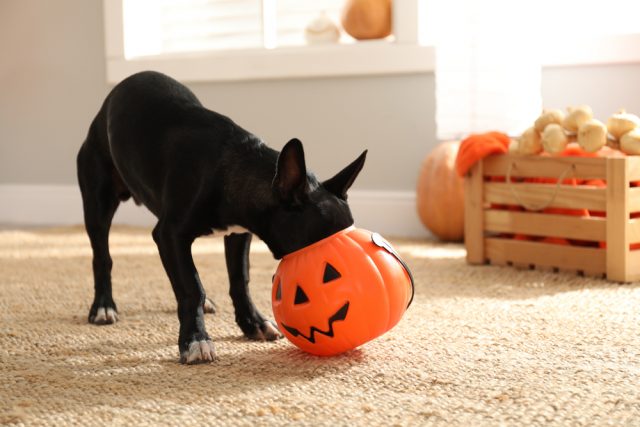Halloween can be a fun time to dress up the dogs and kids and go to a party or hand out candy. However, for dogs with anxiety or fear, October is a frightful month, full of monsters (literally!) at every house, strange sounds, and waaaay to many people coming to the door.
Help your dog get through this scary season with these training and management tips.
Before Halloween Night
Costumes
Get your dog used to the idea of costumed kids and people.
- Start with easy costumes – a strange hat, furry coat, weird sunglasses, etc. – and build up to full costumes with masks.
- It’s easier on the dog if you put the costume on in front of them rather than come out a room looking weird.
- Immediately start tossing treats to your dog and say “good” as he is eating them.
- Slowly walk to your dog, keeping your body turned away from them (so don’t walk directly at them), continually throwing treats.
- If your dog comes up to you, great! Pet them and feed them treats.
- If they don’t, do not PUSH your dog! Do not walk right up to him.
- If your dog will not eat, runs and hides, or shows other signs of stress or fear, leave. Wait 3 minutes, if your dog is calm, try it again. If they are not calm, you need make the costume less scary (to the dog).
Dressing your dog up can be fun too, but ONLY if your dog is willing. Don’t put your dog through more stress by forcing them to dress up.
Sights & Sounds
A lot of neighborhoods decorate for Halloween now, meaning that your daily walk may be littered with large decoration, scary motion-sensing animated features, and strange lights.
- If you have decorations yourself, take advantage by doing some Look At That (look at something scary, get a treat) training before you even leave your house. Present the items one at a time for your dog to investigate.
- Take your dog out during the day when the decorations are easier to see, and most of the animated/lighted features will be off.
- Give your dog cookies as she looks at or approaches any of these decorations. Be careful not to destroy any of the neighbor’s property. Your dog doesn’t necessarily need to go up and sniff it, but just look at it and not be worried
- Then walk your dog at dusk, repeat the cookie process.
- Finally, walk your dog at night, repeat the cookie process.
Doorbell/Knocking
If your dog has a problem with the doorbell and/or knocking, you can work on giving them a job to do (like go into their kennel, go to a mat, go lie down in a given spot) to help them handle Halloween night. However, unless you are really dedicated to practicing this entire month, you are probably not going to have the finished behavior ready for a night with that much activity.
Instead, work on just desensitizing the sound. Have someone knock on the door or ring the bell while you toss cookies. Remember Pavlov’s dogs? You are basically doing the same thing with the doorbell and knock as he did with the bell. This way, your dog will expect a treat when the bell rings or there’s a knock at the door.
This practice also helps because your dog learns that just because he hears that noise, does not mean there is someone at the door, helping them relax a bit.
Halloween Night
It’s the big night! Make sure you have plenty of treats for the dog on hand, for reward purposes. HOWEVER, this is NOT the night to try and get a fearful dog “over” things. If you have been working with your dog all month and they are still afraid of things, you need some management for the night.
For the (still) fearful dog:
- Take your dog out for a walk early, before trick-or-treaters come out.
- Put them in a room away from the front door.
- Give them a fun toy, chew bone, etc.
- Turn on a TV or radio to provide some “white noise”
- Put a note on your door asking kids to not ring the doorbell or knock. Instead, either leave the candy on the porch, sit on the porch with it, or leave your door open.
If your dog responded well to your work leading up the Halloween, have them with you to continue reinforcing that all these strange things and people mean treats. But don’t overdo it. Don’t make your dog sit there for hours if they seem a bit stressed. Pay attention to your dog and when they have had enough, but them in another room with their Halloween treat.

Above all, be safe and watch your dogs for signs of stress. Stressed and scared dogs bite, and you don’t want yours biting a child or parent out of fear. Halloween is fun, but it’s not for every dog. If you think there is even a chance your dog may not enjoy the festivities, it’s better to leave them out than to have the unthinkable happen.
And remember, NO CANDY for the dog! Give them dog cookies or a chew bone instead.



 Toledo, United States.
Toledo, United States.
